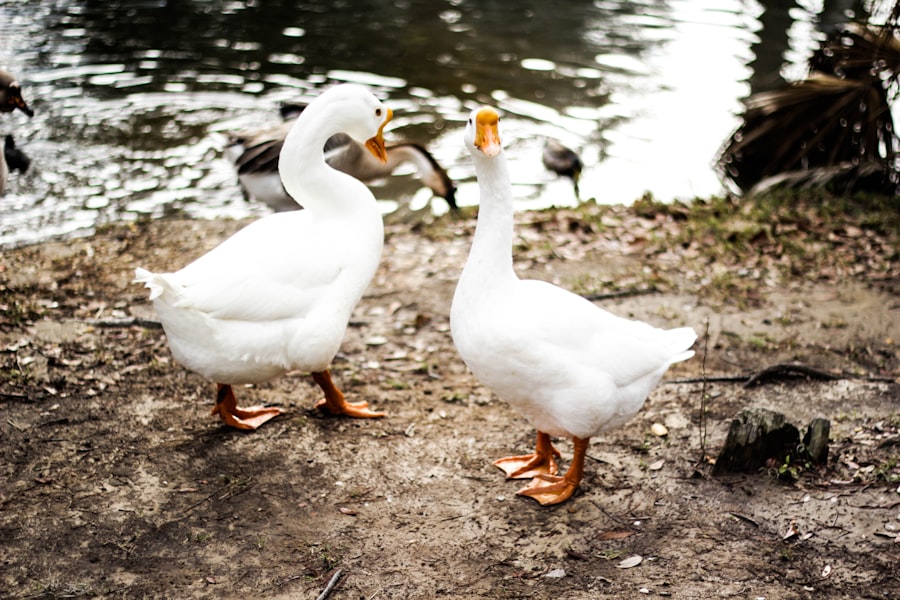Geese can be a nuisance when they invade your property, leaving behind droppings and causing damage to lawns and gardens. Finding a humane way to keep geese away is important to maintain the cleanliness and integrity of your property. One effective method that has gained popularity in recent years is using string as a deterrent for geese. This article will explore the benefits of using string, how to choose the right type of string, the science behind why it works, tips for setting up a string barrier, maintenance and upkeep, alternative methods, common mistakes to avoid, and success stories from those who have used string to keep geese away.
Key Takeaways
- Using string is an effective and humane way to deter geese from your property.
- String barriers can save time and money compared to other methods of goose control.
- Choosing the right type of string is important for maximum effectiveness.
- The science behind string as a goose deterrent involves disrupting their flight patterns.
- Proper setup and maintenance of string barriers is crucial for long-term success.
The Benefits of Using String to Keep Geese Away
Using string as a deterrent for geese offers several advantages over other methods. Firstly, it is a non-lethal and humane way to keep geese at bay. Unlike other methods such as traps or chemical repellents, string does not harm the geese in any way. It simply creates a physical barrier that discourages them from entering your property.
Secondly, using string is cost-effective. Compared to other methods that may require ongoing expenses or professional services, string is a one-time investment. Once you have set up the string barrier, it requires minimal maintenance and can last for a long time.
Lastly, using string is environmentally friendly. Many other methods of goose deterrence involve the use of chemicals or harmful substances that can have negative effects on the environment. String, on the other hand, is a natural and sustainable option that does not pose any harm to the ecosystem.
How to Choose the Right Type of String for Geese Deterrence
When choosing the right type of string for goose deterrence, there are several factors to consider. Firstly, you need to determine the height at which you want to set up the string barrier. Geese are tall birds and can easily step over low barriers. Therefore, it is recommended to set the string at least 2-3 feet above the ground to ensure it is effective.
Secondly, consider the visibility of the string. Geese have excellent eyesight and can easily spot obstacles in their path. Choose a string that is highly visible, such as brightly colored or reflective string, to ensure that the geese are deterred from entering your property.
Lastly, consider the durability of the string. Geese can be persistent and may try to break through the barrier. Choose a strong and durable string that can withstand their attempts to penetrate it. Nylon or polypropylene strings are often recommended for their strength and longevity.
The Science Behind Why String Works as a Goose Deterrent
The effectiveness of string as a goose deterrent lies in the birds’ natural instincts and behaviors. Geese have a strong aversion to obstacles in their path, especially when they are unable to see what lies beyond them. When they encounter a string barrier, they perceive it as a physical obstacle and are hesitant to cross it.
Furthermore, geese have a natural fear of predators. The presence of string mimics the appearance of a predator’s trap or snare, triggering their instinctual response to avoid potential danger. This fear response is ingrained in their DNA and helps them survive in the wild.
Additionally, geese are social animals that rely on visual cues from other members of their flock for safety. When they see other geese avoiding or hesitating to cross a string barrier, they interpret it as a sign of danger and are more likely to follow suit.
Tips for Setting Up a String Barrier to Keep Geese Away
Setting up a string barrier to keep geese away requires careful planning and execution. Here are some step-by-step instructions on how to do it effectively:
1. Determine the perimeter: Identify the areas where you want to keep geese away and measure the perimeter. This will help you determine the amount of string you will need.
2. Install posts: Place sturdy posts at regular intervals along the perimeter. These posts will serve as anchor points for the string.
3. Attach the string: Tie one end of the string to a post and stretch it to the next post, making sure it is at least 2-3 feet above the ground. Repeat this process until you have covered the entire perimeter.
4. Secure the string: Use zip ties or clips to secure the string to the posts, ensuring that it is taut and cannot be easily moved or dislodged by wind or geese.
5. Add visual deterrents: To enhance the effectiveness of the string barrier, consider adding visual deterrents such as flags or reflective tape. These will further deter geese from approaching the area.
Maintenance and Upkeep of Your String Barrier for Long-Term Effectiveness

To ensure the long-term effectiveness of your string barrier, regular maintenance and upkeep are necessary. Here are some tips to keep your string barrier in good condition:
1. Inspect regularly: Regularly inspect your string barrier for any signs of damage or wear. Replace any broken or frayed strings immediately to maintain the integrity of the barrier.
2. Adjust as needed: Geese may attempt to find ways around or under the string barrier. Monitor their behavior and adjust the height or position of the strings accordingly to prevent them from finding loopholes.
3. Keep vegetation trimmed: Overgrown vegetation can provide geese with cover and make it easier for them to approach your property. Keep the area around the string barrier well-trimmed to eliminate hiding spots.
4. Clean up droppings: Geese are attracted to areas with ample food sources, such as lawns with abundant droppings. Regularly clean up any droppings within and around the string barrier to discourage geese from returning.
Other Natural and Humane Ways to Deter Geese from Your Property
While using string as a goose deterrent is effective, there are other natural and humane methods you can consider as well. Here are a few alternatives:
1. Landscaping modifications: Geese are attracted to open spaces with easy access to water. Modifying your landscaping by adding dense shrubs or tall grasses can make your property less appealing to geese.
2. Water deterrents: Geese prefer open water for feeding and resting. Installing motion-activated sprinklers or floating devices in ponds or lakes can deter geese from settling in those areas.
3. Noise deterrents: Geese are sensitive to loud noises and unfamiliar sounds. Using noise deterrents such as wind chimes, ultrasonic devices, or even playing recordings of predator calls can discourage geese from approaching your property.
Common Mistakes to Avoid When Using String as a Goose Deterrent
While using string as a goose deterrent is effective, there are some common mistakes that people make which can reduce its effectiveness. Here are a few tips to avoid these mistakes:
1. Inadequate height: Setting the string too low can allow geese to easily step over it. Make sure the string is at least 2-3 feet above the ground to create an effective barrier.
2. Insufficient visibility: Geese have excellent eyesight and can easily spot obstacles in their path. Choose a highly visible string, such as brightly colored or reflective string, to ensure that it is easily seen by the geese.
3. Lack of maintenance: Neglecting regular maintenance and upkeep of the string barrier can lead to its deterioration and reduced effectiveness. Regularly inspect and repair any damage to ensure the barrier remains intact.
Success Stories from Those Who Have Used String to Keep Geese Away
Many people have successfully used string as a goose deterrent and have shared their success stories. One homeowner in a suburban neighborhood had been struggling with geese invading his property for years. After setting up a string barrier, he noticed an immediate decrease in the number of geese visiting his lawn. The geese would approach the string barrier but would hesitate to cross it, eventually giving up and moving on to other areas.
Another success story comes from a golf course that had been dealing with geese causing damage to their greens and fairways. They installed a string barrier around the perimeter of the course and saw a significant reduction in the number of geese on their property. The geese would approach the string barrier but would turn away, avoiding the area altogether.
These success stories highlight the effectiveness of using string as a goose deterrent and demonstrate that it is a viable solution for keeping geese away from your property.
Why Using String is an Effective and Ethical Way to Keep Geese at Bay
In conclusion, using string as a deterrent for geese offers several benefits. It is a non-lethal and humane method that effectively keeps geese away from your property. String is cost-effective, environmentally friendly, and easy to set up. By choosing the right type of string, understanding the science behind why it works, and following proper maintenance and upkeep, you can create a long-lasting barrier that effectively deters geese.
While using string is an effective method, it is important to explore other natural and humane ways to deter geese as well. By implementing landscaping modifications, water deterrents, or noise deterrents, you can further discourage geese from settling on your property.
By avoiding common mistakes and learning from success stories, you can successfully use string as a goose deterrent and enjoy a goose-free property. Remember, finding humane solutions to keep geese away is not only beneficial for your property but also contributes to the overall well-being of these beautiful birds.
If you’re interested in effective ways to keep geese away, you might also find this article on converting a shed into a chicken coop from Poultry Wizard helpful. It provides valuable insights on repurposing existing structures to create a safe and comfortable home for your chickens. Check it out here. Additionally, if you’re looking for tips on the ideal flooring for your chicken coop, this article from Poultry Wizard offers practical advice and considerations. Discover more about the floor options for your coop here. Lastly, if you’re interested in the portability of chicken coops, this article from Poultry Wizard explores the benefits and considerations of having a portable chicken coop. Learn more about chicken coop portage here.
FAQs
What is the article about?
The article is about using string as a humane and effective method to keep geese away from certain areas.
Why do people want to keep geese away?
Geese can cause damage to property, create a mess with their droppings, and pose a potential health risk with their feces. They can also be aggressive towards humans and other animals.
How does using string keep geese away?
Geese are deterred by obstacles that impede their movement, and string creates a physical barrier that they are hesitant to cross. The string can be set up in a way that creates a visual deterrent as well.
Is using string a humane method to keep geese away?
Yes, using string is considered a humane method as it does not harm the geese in any way. It simply creates a barrier that they are reluctant to cross.
What type of string is best to use?
A strong, durable string such as monofilament fishing line or twine is recommended. It should be thin enough to be difficult for the geese to see, but strong enough to withstand wind and weather.
Where should the string be placed?
The string should be placed in a way that creates a physical barrier between the geese and the area you want to protect. It can be strung between poles or trees, or anchored to the ground with stakes.
Are there any other methods to keep geese away?
Other methods include using decoys, noise makers, and chemical repellents. However, these methods may not be as effective or humane as using string.
Meet Walter, the feathered-friend fanatic of Florida! Nestled in the sunshine state, Walter struts through life with his feathered companions, clucking his way to happiness. With a coop that’s fancier than a five-star hotel, he’s the Don Juan of the chicken world. When he’s not teaching his hens to do the cha-cha, you’ll find him in a heated debate with his prized rooster, Sir Clucks-a-Lot. Walter’s poultry passion is no yolk; he’s the sunny-side-up guy you never knew you needed in your flock of friends!







